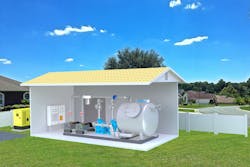Packaged Vacuum Stations Include Prefabricated Building
Airvac offers three versions of a packaged vacuum (PacVac) station that includes not only the same vacuum station components as its custom-engineered stations, but also a prefabricated building to house it.
Cost savings: The significant cost savings compared to a custom-designed vacuum station are the greatest advantage to using any PacVac station. With no equipment to assemble and no building structure to construct on site, the contractor’s effort is greatly reduced.
Standard, yet flexible: The standardization of key components keeps things simple with PacVac. Within each version, several models are available, allowing the designer to match the available component equipment to the size of the project.
Collection tank: A fiberglass collection tank is used in all PacVac stations. Versions 1 and 2 use a 1,300-gal tank, while four sizes are available in Version 3 (1,500, 2,000, 2,500 and 3,000 gal). The collection tank is contained within the structure of Versions 1 and 2, and it is directly buried in Version 3.
Sewage pumps: In all PacVac stations, two sewage pumps are used. In Version 1, these are on the same level as all other equipment; in Version 2, they are in a basement vault; and in Version 3, they are in a pump vault. The size varies according to peak flow and head conditions.
Vacuum pumps: In all PacVac stations, either two or three vacuum pumps are used. The capacity ranges from 103 to 353 cu ft per minute (cfm) when Busch Mink pumps are used, and from 117 to 455 cfm when Busch R5 pumps are used.
Prefabricated building: The use of a prefabricated building supplied by Airvac is a significant cost savings factor in all PacVac stations. Each version has a building sized specifically for the equipment it houses.
